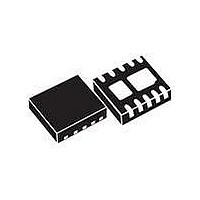MAX11102ATB+T Maxim Integrated Products, MAX11102ATB+T Datasheet - Page 28

MAX11102ATB+T
Manufacturer Part Number
MAX11102ATB+T
Description
IC ADC 12BIT SPI/SRL 10TDFN
Manufacturer
Maxim Integrated Products
Datasheet
1.MAX11117AUTT.pdf
(30 pages)
Specifications of MAX11102ATB+T
Number Of Bits
12
Sampling Rate (per Second)
2M
Data Interface
MICROWIRE™, QSPI™, Serial, SPI™
Number Of Converters
1
Power Dissipation (max)
1.95W
Voltage Supply Source
Single Supply
Operating Temperature
-40°C ~ 125°C
Mounting Type
Surface Mount
Package / Case
10-WFDFN Exposed Pad
Conversion Rate
2 MSPs
Resolution
12 bit
Interface Type
Serial (3-Wire, SPI, QSPI, Microwire)
Snr
73 dB
Voltage Reference
1 V
Supply Voltage (max)
3.6 V
Supply Voltage (min)
2.2 V
Maximum Power Dissipation
1951 mW
Maximum Operating Temperature
+ 125 C
Mounting Style
SMD/SMT
Input Voltage
2.2 V to 3.6 V
Minimum Operating Temperature
- 40 C
Lead Free Status / RoHS Status
Lead free / RoHS Compliant
Other names
MAX11102ATB+TTR
2Msps/3Msps, Low-Power,
Serial 12-/10-/8-Bit ADCs
Integral nonlinearity (INL) is the deviation of the values
on an actual transfer function from a straight line. For
these devices, the straight line is a line drawn between
the end points of the transfer function after offset and
gain errors are nulled.
Differential nonlinearity (DNL) is the difference between
an actual step width and the ideal value of 1 LSB. A DNL
error specification of ±1 LSB or less guarantees no mis-
sing codes and a monotonic transfer function.
The deviation of the first code transition (00 . . . 000) to
(00 . . . 001) from the ideal, that is, AGND + 0.5 LSB.
The deviation of the last code transition (111 . . . 110) to
(111 . . . 111) from the ideal after adjusting for the offset
error, that is, V
Aperture jitter (t
the time between the samples.
Aperture delay (t
of sampling clock and the instant when an actual sample
is taken.
SNR is a
verter’s noise performance. For a waveform perfectly
reconstructed from digital samples, the theoretical maxi-
mum SNR is the ratio of the full-scale analog input (RMS
value) to the RMS quantization error (residual error).
The ideal, theoretical minimum analog-to-digital noise
is caused by quantization error only and results directly
from the ADC’s resolution (N bits):
In reality, there are other noise sources such as thermal
noise, reference noise, and clock jitter that also degrade
SNR. SNR is computed by taking the ratio of the RMS
signal to the RMS noise. RMS noise includes all spectral
components to the Nyquist frequency excluding the
fundamental, the first five harmonics, and the DC offset.
28
_____________________________________________________________________________________
SNR (dB) (MAX) = (6.02 x N + 1.76) (dB)
dynamic figure
REF
AJ
AD
) is the sample-to-sample variation in
- 1.5 LSB.
) is the time between the falling edge
Signal-to-Noise Ratio (SNR)
Differential Nonlinearity
of merit that indicates the con-
Integral Nonlinearity
Aperture Delay
Aperture Jitter
Definitions
Offset Error
Gain Error
SINAD is a
converter’s noise and distortion performance. SINAD
is computed by taking the ratio of the RMS signal to
the RMS noise plus distortion. RMS noise plus distor-
tion includes all spectral components to the Nyquist
frequency excluding the fundamental and the DC offset:
.
Total harmonic distortion (THD) is the ratio of the RMS
sum of the first five harmonics of the input signal to the
fundamental itself. This is expressed as:
where V
the amplitudes of the 2nd- through 5th-order harmonics.
SFDR is a
est usable input signal amplitude. SFDR is the ratio of
the RMS amplitude of the fundamental (maximum signal
component) to the RMS value of the next largest spuri-
ous component, excluding DC offset. SFDR is specified
in decibels with respect to the carrier (dBc).
Full-power bandwidth is the frequency at which the input
signal amplitude attenuates by 3dB for a full-scale input.
Full-linear bandwidth is the frequency at which the
signal-to-noise ratio and distortion (SINAD) is equal to a
specified value.
Any device with nonlinearities creates distortion prod-
ucts when two sine waves at two different frequencies
(f
distortion (IMD) is the total power of the IM2 to IM5 inter-
modulation products to the Nyquist frequency relative to
the total input power of the two input tones, f
individual input tone levels are at -6dBFS .
1
SINAD(dB)
and f
Spurious-Free Dynamic Range (SFDR)
1
2
THD 20 log
) are applied into the device. Intermodulation
Signal-to-Noise Ratio and Distortion
is the fundamental amplitude and V
dynamic figure
dynamic figure
=
=
20 log
×
×
Intermodulation Distortion
Total Harmonic Distortion
(
NOISE DISTORTION
of merit that indicates the low-
V
2
Full-Power Bandwidth
Full-Linear Bandwidth
2
of merit that indicates the
+
V
SIGNAL
+
3
2
V
1
+
V
4
2
RMS
+
V
1
5
2
and f
(SINAD)
)
2
RMS
–V
2
5
. The
are











